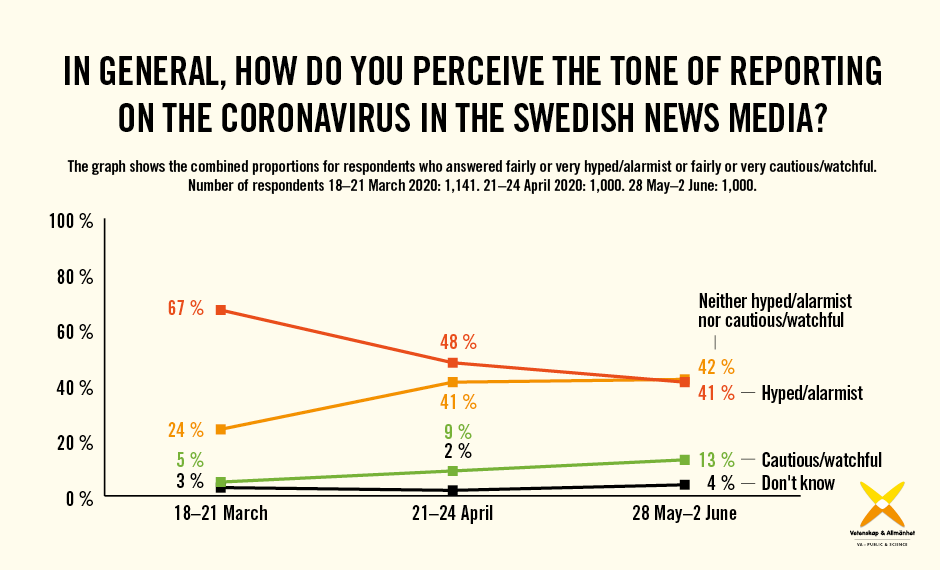After a significant increase in April, the Swedish public’s confidence in government officials is now back at the same level as it was in March. Swedish Television (SVT) remains the media channel that most Swedes access for news about the coronavirus. These are the latest findings of a study being conducted by the Swedish non-profit organisation VA (Public & Science).
In collaboration with researchers from the Karolinska Institute and Södertörn University, VA (Public & Science) is conducting a study of how people are receiving and interpreting information about the coronavirus and the ongoing pandemic. Here, we present the findings from the fifth wave of the survey, which was undertaken between 28 May – 2 June 2020.
Less hyped reporting
Four out of ten Swedes perceive that the tone of reporting on the coronavirus in the Swedish news is fairly or very hyped/alarmist. This is slightly lower than at the end of April, and significantly lower than at the end of March, when two out of three Swedes (67 percent) felt that tone of reporting was hyped/alarmist. This perception is fairly evenly distributed among the population although certain differences can be seen between people with different income levels. Among those with higher incomes (over SEK 42,000/month), 47 percent perceive the tone as fairly or very hyped/alarmist, compared with 35 percent among people earning less than SEK 25,000/month. No corresponding difference is visible between people with different educational levels. Around one in ten Swedes perceive the tone to be cautious/watchful, while four out of ten consider it to be neither hyped/alarmist nor cautious/watchful.

SVT is the most common source of news
As in previous waves of the survey, the most common source of news about the coronavirus is Swedish Television (SVT), which 64 percent of Swedes had accessed in the preceding two days. Four out of ten Swedes (38 percent) got information from TV4, Swedish Radio (SR) and the tabloid Aftonbladet respectively. Most media channels remain at the same or a slightly lower level compared to the end of April. The clearest decrease can be seen for SVT and TV4.
People aged 70 or older consume more news from local morning newspapers (43 percent), Svenska Dagbladet (17 percent), Swedish Television (SVT) (84 percent), Swedish Radio (51 percent) and TV4 (50 percent) compared to others. On the other hand, they read the tabloid Aftonbladet to a lesser extent (27 percent). High-income earners consume more of the media channels to a higher extent than those with lower incomes.

Reduced confidence in government officials
The proportion of Swedes who say that they have a fairly or very high level of confidence in government officials that comment on the coronavirus has fallen from 68 percent to 60 percent since the previous survey in mid-May. Confidence is therefore back at the same level as it was when the first survey was conducted in March. Otherwise, there has been no change in Swedes’ confidence in the different professional groups. As seen in the previous waves, confidence is highest for doctors and other healthcare professionals (89 percent), followed by researchers (82 percent), government officials (60 percent), politicians (27 percent) and journalists (17 percent).

About the survey
The survey was conducted by Kantar Sifo and consisted of 1,000 interviews with a web panel based on random sampling. The interviews were conducted between 28 May–2 June. The results are weighted based on gender, age and region of residence.
Ongoing studies
In order to monitor the Swedish public’s news consumption, confidence in key professional groups and attitudes towards media reporting over time, we intend to conduct further studies during the course of the pandemic. We also plan to undertake a content analysis of reporting on the coronavirus in the Swedish media in order to map any changes in reporting during different phases, and how this relates to public attitudes during the same time period.
The study is being conducted with the support of the Anne-Marie and Gustaf Anders Foundation for Media Research, LIF – the Swedish Association of the Pharmaceutical Industry, the Wenner-Gren Foundations and the Swedish Research Council.
Read more about VA’s study and the results of the first, second, third and fourth waves of the study.

